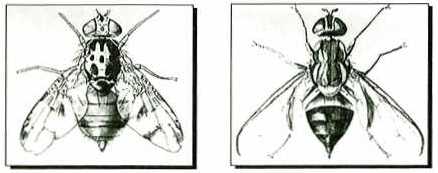1897
News that Qfly was damaging fruit around Sydney in the mid 1890s was quickly noted by South Australian fruit growers, and in 1897 the Cherry Gardens branch of the Agricultural Bureau of South Australia requested that, “this conference ....respectfully requests the Central Bureau to....take all necessary precautions to prevent fruit fly being introduced on fruit from Queensland and New South Wales”. As a result, a Proclamation under the Vine and Fruit Protection Act 1885 was issued in 1897 prohibiting the introduction of Qfly. After the turn of the century, Medfly and all other insects known as the fruit fly, were declared to be insects within the meaning of the Act, and their introduction prohibited. Many South Australian fruit growers were convinced that both species of fruit flies could establish in South Australia if they were introduced, but some argued that “fruit flies could not live under our conditions”.
In the ten years following 1897, much of the framework for the policy and operational procedures of excluding fruit flies from South Australia was formed. Fumigation of incoming fruit (with hydrogen cyanide) was first suggested in 1897 to prevent the “dreaded” (Queensland) fruit fly becoming established in the colony of South Australia. However fumigation was probably not used on a routine basis, and inspection of all incoming fruit appears to have been the main protection. After an outbreak of medfly at Horsham, Victoria, in 1907, all importation of fruit except through Port Adelaide was prohibited; any person introducing fruit by road or rail was liable to a £100 penalty. In 1907, the first report of fruit flies on incoming fruit was made after a small parcel of oranges infested with fruit flies was destroyed at Port Adelaide. Recognising that the risk of introduction of fruit fly was greatest from travellers rather than from commercial shipments, the fruit growing industry recommended a publicity campaign warning travellers against carrying fruit.
The first comprehensive analysis of the fruit fly risks to South Australia was given in 1907 by George Quinn, the Government Horticultural Instructor. This analysis has formed the basis of government policy to the present day. Quinn asked the question “what we, in the interests of our local producers and consumers should do to avert as long as possible, the advent of this scourge in our midst?”. He proposed, “the first step is for educating our people as to its identity”, then to “maintain a rigid hold over the ingress of all fruits”. In case of a small fruit fly outbreak, he noted “that there is hope that an isolated outbreak may be stamped out is supported by the fact that a small infestation in a garden in Launceston was eradicated by speedy treatment of the soil with kerosene and destruction of all fruit by boiling”
During the first ten years of the fruit fly “scare”, growers from commercial fruit growing areas of South Australia urged the government to ban imports of all fruit from other states, but Quinn opposed absolute prohibition because he recognised the two-way nature of trade, “we have large interests to maintain (by) keeping markets in the adjoining states open to our fruits”. This became apparent to South Australian producers when Victorian inspectors bred a “Mediterranean fruit fly” from oranges grown in South Australia in 1908. Quinn remarked that he was unable to confirm the presence of Med fly in the South Australian source orchard despite diligent searching, and implies the Victorian inspectors mis-identified med fly for the metallic—green tomato fly, Lamprolonchaea brouniana.
Once this quarantine procedure was operational, there are few records of fruit interceptions until 1947. But the restrictions caused irritation to at least one South Australian grower in 1924, who was the first person to be charged under the act for “obstructing an inspector, and accompanying his obstructions with threats of violence” and was fined £2 plus 15 shillings costs.
Fruit flies
Fruit flies, members of the insect family Tephretidae (formerly known as Trypetidae) are found in many tropical and sub tropical parts of the world. Australia has a number of species of native fruit flies, the most important of which is Queensland fruit fly or Qfly, Bactrocera tryoni (formerly known as Strumeta or Dacus tryoni). An introduced species, Mediterranean fruit fly or Medfly, Ceratitis capitata, presently occurs in parts of Western Australia. Males of the inland fruit fly, Dacus newmani are commonly found in traps in South Australia; neither females of this species, nor their host is known. They have never been recorded on commercial fruit.

The first recorded outbreak of fruit fly in South Australia occurred in 1947, when a large outbreak of Qfly was found in Adelaide. This report describes action taken by the State Government and its Department of Agriculture, and entomologists of the University of Adelaide’s Department of Entomology, Waite Agricultural Research Institute, to eradicate that outbreak.
